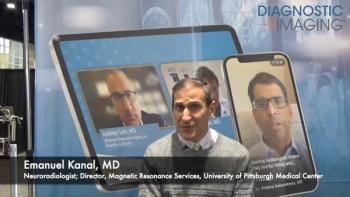
A Knee MRI in Half the Time? It’s Possible
Cutting the time for a knee MRI protocol in half can accelerate image capture without compromising image resolution or quality.
It’s possible to capture the same quality images with MRI for some painful knee conditions in half the time, according to new research.
According to a study from Johns Hopkins University School of Medicine, published in
“Rapid knee MRI using combined simultaneous multi-slice (SMS) technique and parallel imaging (PI) acceleration can add value through reduced acquisition time but requires validation of clinical efficacy,” said the team of investigators led by Filippo Del Grande, M.D.
A parallel imaging acquisition protocol or multi-slice acquisition captured at the same time are typical methods providers use to image and diagnose knee conditions with MRI in less time. But, is 10-minute scan short enough? Del Grande’s team wondered it were possible to cut that time in half.
Related Content:
For their study, they enrolled 252 patients between April 2018 and October 2019 and performed knee MRI scans using either a standard two-fold parallel turbo spin-echo 10-minute scan or a four-fold, multi-slice/parallel imaging-accelerated, turbo spin-echo protocol in 5 minutes. Patients were imaged on either a 1.5T scanner (104 patients) or a 3T scanner (148 patients).
The scans were examined by three radiologists who evaluated them for meniscal, tendinous, ligamentous, and osseocartilaginous injuries. Using these assessments, Del Grande’s team compared protocol performance and found no statistically significant differences between the 5-minute and 10-minute protocols, indicating they performed equivalently across knee conditions and magnet strengths.
Specifically, they said, inter-method agreements, measured by kappa coefficient, were good at 1.5T and very good at 3T -- >0.71 and >0.83, respectively. In addition, the diagnostic performances of both the 5-minute and 10-minute protocols were similar for 1.5T, as well as 3T, with areas under the curve of >0.78 and >0.83, respectively.
These results, the team said, demonstrate that combined SMS and PI acceleration for 5-minute, five-sequence 1.5T and 3T knee MRI is clinically feasible.
Outside experts agreed, in an accompanying
“This study brings us one step closer to establishing a new normal: the 5-minute knee MRI,” he said.
For more coverage based on industry expert insights and research, subscribe to the Diagnostic Imaging e-Newsletter
Newsletter
Stay at the forefront of radiology with the Diagnostic Imaging newsletter, delivering the latest news, clinical insights, and imaging advancements for today’s radiologists.




























